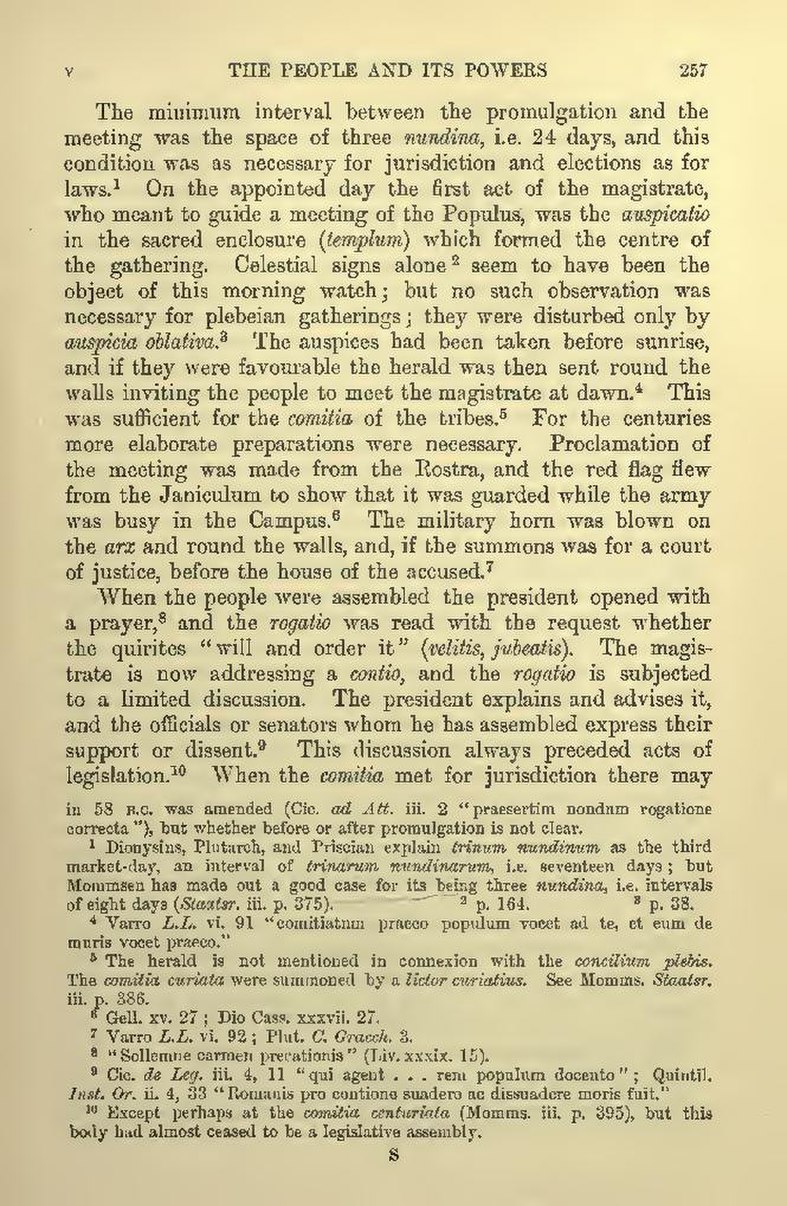The minimum interval between the promulgation and the meeting was the space of three nundina, i.e. 24 days, and this condition was as necessary for jurisdiction and elections as for laws.[1] On the appointed day the first act of the magistrate, who meant to guide a meeting of the Populus, was the auspicatio in the sacred enclosure (templum) which formed the centre of the gathering. Celestial signs alone[2] seem to have been the object of this morning watch; but no such observation was necessary for plebeian gatherings; they were disturbed only by auspicia oblativa.[3] The auspices had been taken before sunrise, and if they were favourable the herald was then sent round the walls inviting the people to meet the magistrate at dawn.[4] This was sufficient for the comitia of the tribes.[5] For the centuries more elaborate preparations were necessary. Proclamation of the meeting was made from the Rostra, and the red flag flew from the Janiculum to show that it was guarded while the army was busy in the Campus.[6] The military horn was blown on the arx and round the walls, and, if the summons was for a court of justice, before the house of the accused.[7]
When the people were assembled the president opened with a prayer,[8] and the rogatio was read with the request whether the quirites "will and order it" (velitis, jubeatis). The magistrate is now addressing a contio, and the rogatio is subjected to a limited discussion. The president explains and advises it, and the officials or senators whom he has assembled express their support or dissent.[9] This discussion always preceded acts of legislation.[10] When the comitia met for jurisdiction there may
- [Footnote: in 58 B.C. was amended (Cic. ad Att. iii. 2 "praesertim nondum rogatione
correcta"), but whether before or after promulgation is not clear.]
- ↑ Dionysius, Plutarch, and Priscian explain trinum nundinum as the third market-day, an interval of trinarum nundinarum, i.e. seventeen days; but Mommsen has made out a good case for its being three nundina, i.e. intervals of eight days (Staatsr. iii. p. 375).
- ↑ p. 164.
- ↑ p. 38.
- ↑ Varro L.L. vi. 91 "comitiatum praeco populum vocet ad te, et eum de muris vocet praeco."
- ↑ The herald is not mentioned in connexion with the concilium plebis. The comitia curiata were summoned by a lictor curiatius. See Momms. Staatsr. iii. p. 386.
- ↑ Gell. xv. 27; Dio Cass. xxxvii. 27.
- ↑ Varro L.L. vi. 92; Plut. C. Gracch. 3.
- ↑ "Sollemne carmen precationis" (Liv. xxxix. 15).
- ↑ Cic. de Leg. iii. 4, 11 "qui agent . . . rem populum docento"; Quintil. Inst. Or. ii. 4, 33 "Romanis pro contione suadere ac dissuadere moris fuit."
